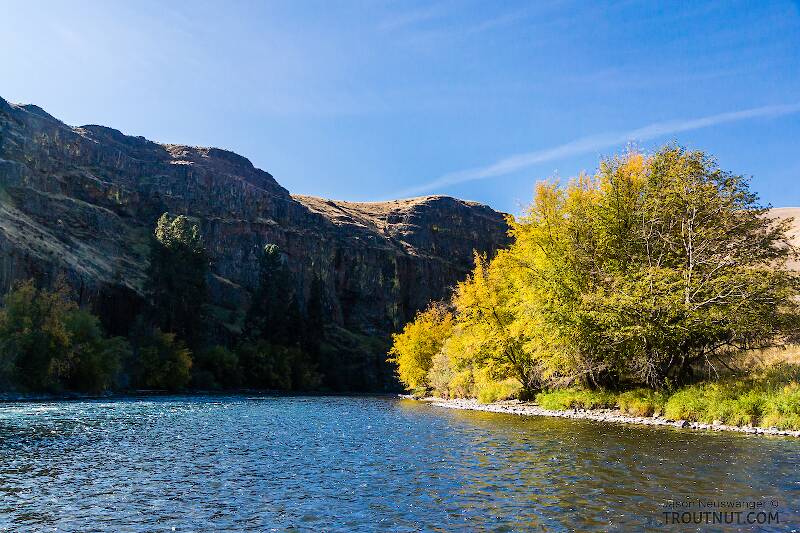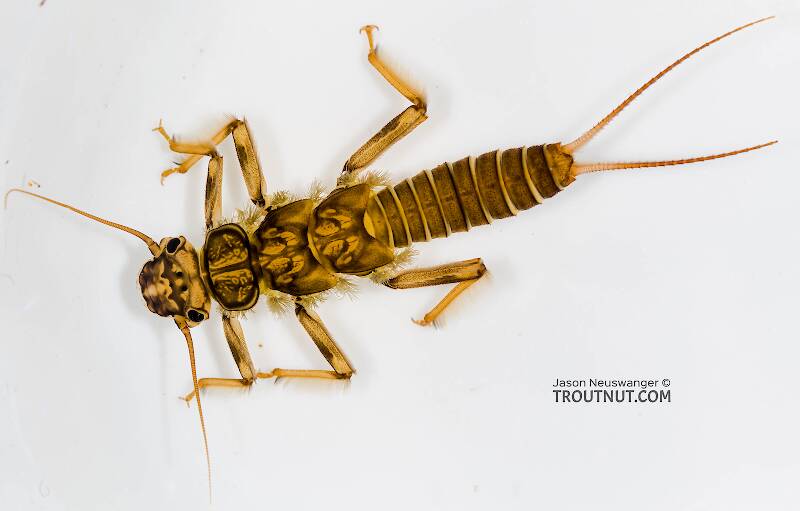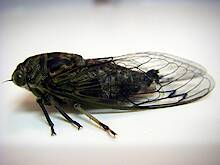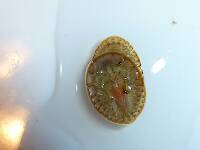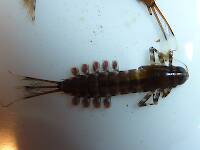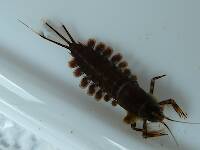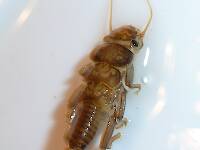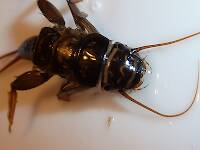
Salmonflies
Pteronarcys californica
The giant Salmonflies of the Western mountains are legendary for their proclivity to elicit consistent dry-fly action and ferocious strikes.
Featured on the forum

Troutnut is a project started in 2003 by salmonid ecologist Jason "Troutnut" Neuswanger to help anglers and
fly tyers unabashedly embrace the entomological side of the sport. Learn more about Troutnut or
support the project for an enhanced experience here.
DayTripper on May 5, 2008May 5th, 2008, 2:08 am EDT
I was hoping someone could help me identify the caddis that were coming off on a small Adirondack stream yesterday. It was about a size 18-20

Also, I'm pretty sure this is a BWO, but does anyone know the latin for this particular flavor of olive? This one was about a size 18-20 as well, but I saw a few that were around a 16

Thanks!

Also, I'm pretty sure this is a BWO, but does anyone know the latin for this particular flavor of olive? This one was about a size 18-20 as well, but I saw a few that were around a 16

Thanks!
GONZO on May 11, 2008May 11th, 2008, 10:54 am EDT
Hey Alex,
I noticed that you had these as Apatania inserta [sic] and Drunella lata on your website. I'm pretty confident that the mayfly is not D. lata. Do you mind me asking how you arrived at those IDs?
I noticed that you had these as Apatania inserta [sic] and Drunella lata on your website. I'm pretty confident that the mayfly is not D. lata. Do you mind me asking how you arrived at those IDs?
Taxon on May 11, 2008May 11th, 2008, 2:20 pm EDT
Lloyd-
I'll take responsibility for that. This is what I responded to Alex when he emailed me to ask my opinion as to identify:
Good catch on my misspelling of A. incerta. When I enlarged the mayfly photo, I believed that I could see a third tail, at least partially broken off, and bent forward beneath the abdomen. So, what do you believe they are?
I'll take responsibility for that. This is what I responded to Alex when he emailed me to ask my opinion as to identify:
I've been good. Thanks for asking. I believe that your BWO is Drunella lata, and your caddisfly is the one identified on Jason's site as Apatania (Early Smoky Wing Sedge), most likely Apatania inserta. Hope this helps.
Good catch on my misspelling of A. incerta. When I enlarged the mayfly photo, I believed that I could see a third tail, at least partially broken off, and bent forward beneath the abdomen. So, what do you believe they are?
Troutnut on May 11, 2008May 11th, 2008, 2:55 pm EDT
The mayfly looks like Epeorus to me. Which species? I can never tell with that genus...
Jason Neuswanger, Ph.D.
Troutnut and salmonid ecologist
Troutnut and salmonid ecologist
Taxon on May 11, 2008May 11th, 2008, 3:41 pm EDT
Jason,
I believe you're correct.
I believe you're correct.
GONZO on May 12, 2008May 12th, 2008, 5:22 am EDT
Hi Roger,
I've looked at these photos several times, and each time gave up in frustration. I wish the images of the wings weren't so confusing.
Here's why I'd rule out lata:
Tails--I considered that a tail might be missing, but the tails also seem unusually long for a lata dun. Right now, I'm leaning toward it being a two-tailed specimen.
Hatch timing--the date that Alex mentions would be at least a month early for the first iteration of lata in the Adirondacks. If anything, one would normally expect hatching in what Alex describes as a "small" stream to be somewhat later.
Size--the first hatches of lata (formerly cornuta) are the largest, typically with females around 10mm and males about 9mm.
Legs--I've never seen an adult lata with femoral markings. (The nymphs may or may not have them.) Additionally, the forelegs of lata duns have beefy, muscular-looking femora.
To me, the femoral markings and two long tails seem to argue for the Epeorus ID that Jason suggests. I'd have more confidence if I could see angled crossveins between the costa and subcosta, but I can't even determine the outline of hindwings from the confusing image.
As for the caddisfly, size and timing would make sense for A. incerta, but the underlying body color appears greenish (?). I don't know any keys for Apatania adults, but what I can see of the wing shape, color, and venation seems pretty similar to brachycentrid wings. Again, a clear image of the costal area of the wing might be helpful.
With the disclaimer that this is all just entertaining speculation, I'd vote for Epeorus and Micrasema.
I've looked at these photos several times, and each time gave up in frustration. I wish the images of the wings weren't so confusing.
Here's why I'd rule out lata:
Tails--I considered that a tail might be missing, but the tails also seem unusually long for a lata dun. Right now, I'm leaning toward it being a two-tailed specimen.
Hatch timing--the date that Alex mentions would be at least a month early for the first iteration of lata in the Adirondacks. If anything, one would normally expect hatching in what Alex describes as a "small" stream to be somewhat later.
Size--the first hatches of lata (formerly cornuta) are the largest, typically with females around 10mm and males about 9mm.
Legs--I've never seen an adult lata with femoral markings. (The nymphs may or may not have them.) Additionally, the forelegs of lata duns have beefy, muscular-looking femora.
To me, the femoral markings and two long tails seem to argue for the Epeorus ID that Jason suggests. I'd have more confidence if I could see angled crossveins between the costa and subcosta, but I can't even determine the outline of hindwings from the confusing image.
As for the caddisfly, size and timing would make sense for A. incerta, but the underlying body color appears greenish (?). I don't know any keys for Apatania adults, but what I can see of the wing shape, color, and venation seems pretty similar to brachycentrid wings. Again, a clear image of the costal area of the wing might be helpful.
With the disclaimer that this is all just entertaining speculation, I'd vote for Epeorus and Micrasema.
DayTripper on May 12, 2008May 12th, 2008, 8:12 am EDT
Thanks to everyone for giving this a shot!
I apologize that the pics don't show as much detail as you would prefer. Although my camera(w30) has descent macro, I took the pics free hand on the stream. I really didn't take them with the intention of getting them properly identified, more for future use at the tying bench, but figured it would be a good idea to have the latin names along with the common on the "fish food" area of my website I'm working on.
I've got a compact/mobile photo studio in the works that I can take on stream with me. Hopefully, I'll be able to get better quality insect pictures.
For future pics, what angles/ body parts would you guys prefer to have closeups of?
Thanks again, it is greatly appreciated!
Alex
I apologize that the pics don't show as much detail as you would prefer. Although my camera(w30) has descent macro, I took the pics free hand on the stream. I really didn't take them with the intention of getting them properly identified, more for future use at the tying bench, but figured it would be a good idea to have the latin names along with the common on the "fish food" area of my website I'm working on.
I've got a compact/mobile photo studio in the works that I can take on stream with me. Hopefully, I'll be able to get better quality insect pictures.
For future pics, what angles/ body parts would you guys prefer to have closeups of?
Thanks again, it is greatly appreciated!
Alex
GONZO on May 12, 2008May 12th, 2008, 8:37 am EDT
Alex,
Please read Dave's (Creno's) comments on the caddisfly photo in the related thread. One of the problems with trying to do IDs from photos is that the amount of information and detail needed can vary from specimen to specimen. For example, any clear photo of an adult green drake (E. guttulata) would be instantly recognizable to species level, even by amateur hacks like me. On the other hand, some species (like some of the Epeorus mayflies) seem to lack definitive keys, and others can only be positively identified by adult male genitalia or larval specimens (in the case of some caddisflies).
I don't know if you have the equipment (or predilection) to go to the trouble of taking close-up shots of insect genitalia. Lacking that, I'd just try to provide as many angles as practical and hope that the some of the important features are captured. One great thing about this site is that, sooner or later, speculation from amateurs like me usually stimulates correction or confirmation from the experts. ;)
Please read Dave's (Creno's) comments on the caddisfly photo in the related thread. One of the problems with trying to do IDs from photos is that the amount of information and detail needed can vary from specimen to specimen. For example, any clear photo of an adult green drake (E. guttulata) would be instantly recognizable to species level, even by amateur hacks like me. On the other hand, some species (like some of the Epeorus mayflies) seem to lack definitive keys, and others can only be positively identified by adult male genitalia or larval specimens (in the case of some caddisflies).
I don't know if you have the equipment (or predilection) to go to the trouble of taking close-up shots of insect genitalia. Lacking that, I'd just try to provide as many angles as practical and hope that the some of the important features are captured. One great thing about this site is that, sooner or later, speculation from amateurs like me usually stimulates correction or confirmation from the experts. ;)
Quick Reply
Related Discussions
Topic
Replies
Last Reply
0
Oct 24, 2006
by Troutnut
by Troutnut
1
Oct 28, 2008
by GONZO
by GONZO
3
Apr 19, 2015
by PaulRoberts
by PaulRoberts
4
May 24, 2008
by Softhackle
by Softhackle
1
Apr 8, 2009
by Troutnut
by Troutnut

